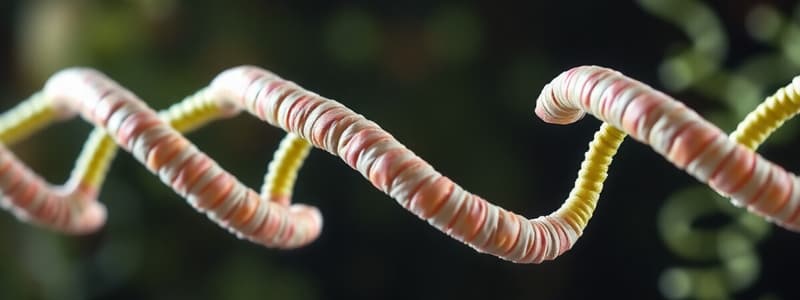Podcast
Questions and Answers
What is the primary process involved in the synthesis of proteins?
What is the primary process involved in the synthesis of proteins?
- Replication
- Absorption
- Transcription and Translation (correct)
- Degradation
Which class of proteins is characterized as structural?
Which class of proteins is characterized as structural?
- Fibrous proteins (correct)
- Globular proteins
- Enzymes
- Membrane proteins
What is produced as a byproduct during protein breakdown in the body?
What is produced as a byproduct during protein breakdown in the body?
- Urea and ammonia (correct)
- Acetyl-CoA and fats
- Lactic acid and water
- Carbon dioxide and glucose
Which method is commonly used for analyzing plasma proteins?
Which method is commonly used for analyzing plasma proteins?
What is the major role of chaperones in protein synthesis?
What is the major role of chaperones in protein synthesis?
Which of the following methods can provide information at atomic resolution for structure determination?
Which of the following methods can provide information at atomic resolution for structure determination?
What fundamental unit is linked together to form proteins?
What fundamental unit is linked together to form proteins?
What was the first protein to be sequenced, marking a significant advancement in biochemistry?
What was the first protein to be sequenced, marking a significant advancement in biochemistry?
What is the primary role of albumin in the blood?
What is the primary role of albumin in the blood?
Which of the following groups are separated in serum protein electrophoresis?
Which of the following groups are separated in serum protein electrophoresis?
What factor is NOT involved in variations of plasma protein concentrations?
What factor is NOT involved in variations of plasma protein concentrations?
How is albumin characterized in terms of its structure?
How is albumin characterized in terms of its structure?
What does the biuret reagent primarily measure?
What does the biuret reagent primarily measure?
Which of the following is a genetic mutation-related protein disorder?
Which of the following is a genetic mutation-related protein disorder?
What is a potential cause for an increase in total protein levels?
What is a potential cause for an increase in total protein levels?
Which condition is NOT associated with hypoproteinaemia?
Which condition is NOT associated with hypoproteinaemia?
What might significantly affect plasma protein levels in a pre-analytical phase?
What might significantly affect plasma protein levels in a pre-analytical phase?
Which of the following may lead to protein metabolism disruption due to environmental factors?
Which of the following may lead to protein metabolism disruption due to environmental factors?
Flashcards are hidden until you start studying
Study Notes
Protein Basics
- Proteins are primarily metabolized in the liver.
- Basic units of proteins are amino acids linked by peptide bonds.
- Protein catabolism results in ammonia and carbon dioxide.
- Urea is produced in the liver and eliminated via urine.
Historical Context
- The term "protein" is derived from the Greek word "prota," meaning "of primary importance."
- Jons Berzelius named proteins in 1838; Frederick Sanger sequenced insulin as the first protein in 1958.
Protein Synthesis and Degradation
- Synthesis involves transcription (converting DNA to mRNA) and translation (mRNA to protein), followed by protein folding.
- Polypeptides achieve functional structures with the assistance of chaperones.
- Degradation is facilitated by the ubiquitin-proteasome system, which tags and degrades damaged proteins.
Protein Structure
- Proteins are not rigid but have unique 3D structures.
- They are categorized into three main classes:
- Globular Proteins: Soluble proteins like albumin, globulins, protamines, and histones.
- Fibrous Proteins: Structural proteins such as keratins and collagen.
- Membrane Proteins: Receptor proteins.
Structure Determination Methods
- X-ray crystallography and NMR spectroscopy are common methods for determining protein structures at atomic resolution.
Electrophoresis for Protein Analysis
- Serum protein electrophoresis separates proteins into five bands, which can be quantified using densiometric scanning.
- Traditional total protein measurement utilizes the biuret reagent.
Serum Proteins
- Serum proteins are divided into six groups: Albumin, α1-globulins, α2-globulins, β1-globulins, β2-globulins, and γ-globulins.
- Albumin is the most abundant plasma protein, constituting 40-60% of total protein.
- Functions of albumin include maintaining colloid osmotic pressure and transporting ions, acids, and hormones.
Plasma Proteins and Clinical Significance
- Plasma proteins provide clinical information useful for diagnosis and monitoring health status.
- Variations in plasma protein levels can arise from changes in synthesis rates, removal rates, or distribution volume.
Protein Disorders
- Genetic mutations: Conditions like cystic fibrosis, sickle cell anemia, and Huntington’s disease can disrupt protein metabolism.
- Environmental toxins, aging, and malnutrition can also affect protein metabolism negatively.
Total Protein Levels
- An increase in total proteins may indicate dehydration, kidney dysfunction, infections, liver disease, or malignancies.
- A decrease in total proteins (hypoproteinemia) can result from inadequate liver production, low intake, hemorrhage, protein loss in urine, severe liver disease, malabsorption, or excessive IV fluids.
Pre-analytical Factors
- Plasma protein levels can be influenced by posture, increasing by 10-20% when standing after lying down.
- Prolonged tourniquet application can also artificially elevate protein concentrations due to increased fluid diffusion from the vascular to interstitial compartments.
Studying That Suits You
Use AI to generate personalized quizzes and flashcards to suit your learning preferences.




